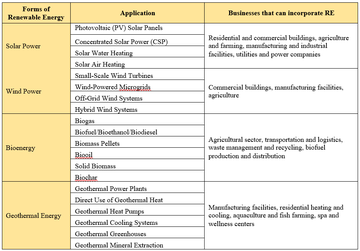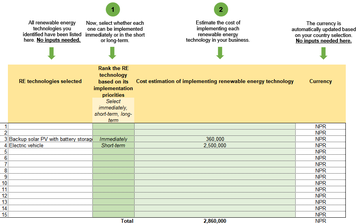Renewable Energy Technologies for Business Operations
Kishor scrolled down. In Section 4.1, He filled in the equipment that his business will require and selected renewable energy technology that is relevant to the reliable operations of each piece of equipment.

Tashi studied the table
“Oh yes! Electric vehicles can replace petrol or diesel-powered delivery vehicles. The majority of electricity sources in Lalalistan are from hydropower anyways. That’s good. As an MSME, you have to identify which renewable energy technologies can support your business against the risk events and also opportunities to transition from greenhouse gas emitting technology by transitioning to renewable energy technology.”

“How can every MSME owner identify which renewable energy technologies can support their businesses?”

“That’s a very good question, Baisali. Since it is the most important step, I have prepared an example for your reference, have a look at this table.”

Tashi scrolled through his smartphone and opened up a document.

“Do you think this will help as a guide?”

Baisali nodded her head in affirmation.
” The table was insightful and it gave a clearer view of forms of renewable energy that can be incorporated in businesses to make them less vulnerable to climate change and its impacts.”

“Yes indeed it does.”

“That’s great! Since you have understood the process of identifying which RE technology to integrate into your businesses to make them least vulnerable to climate change, what is the next step before you decide to implement renewable energy technology?”

Tashi scanned the faces in the group.
“Identify a supplier?”

Tashi shook his head in disagreement.
“That comes later. Keep thinking.”

“The costs.”

“Exactly! Implementing the technology will incur costs. You will at least want to get some estimates. Then you can make decisions on which one you can afford to implement immediately, and similarly, which one you can implement in the short term and long term. Here, short-term means within two years, and long-term means within five years. Although Kishor will have to work on the numbers later, can you put some estimated costs for the renewable energy technologies that you have selected? You need to do this in the next table in Section 4.2 which has automatically summarized the renewable energy technologies for you.”

Kishor (murmuring as he types).
“Solar PV system with battery backup can be implemented immediately and will cost around NPR 360,000 if converted to Nepalese rupees. An electric vehicle can be bought in the short term once I have enough investment and it will cost around NPR 2,500,000.”

“So, what is the total?”

“It is NPR 2,860,000.”


“There – you now know what the cost implication is as well. Well done. Has this helped you plan the implementation of renewable energy technology?”

Everyone in the group nodded in agreement.
“I’ll use this tool to evaluate the climate and natural risks of my business and evaluate the opportunities of renewable energy as well. This has been helpful.”

“I want all of you to do this exercise once you get home. You have seen how we use this tool to see the natural hazards in South Asian countries, and then identify the broader climate & natural risks to the value chain including your own business. After risk identification, you identify the risk response with an eye for potential new product or service opportunities. Finally, you identify renewable energy technologies that can support your business operations with cost implications to understand the practicality of implementation.”

Kishor handed back the laptop to Tashi who then emailed the Excel tool to all in the group.
Average Rating: ☆ ☆ ☆ ☆ ☆ (0 reviews)

